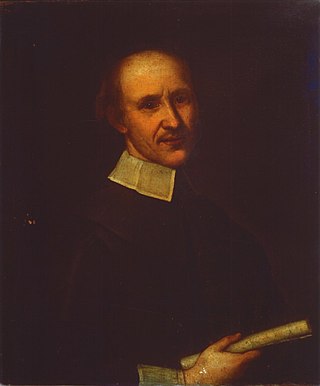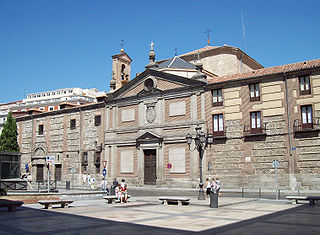Related Research Articles
The year 1715 in music involved some significant events.
Giovanni Bassano was an Italian composer associated with the Venetian School of composers and a cornettist of the late Renaissance and early Baroque eras. He was a key figure in the development of the instrumental ensemble at the basilica of San Marco di Venezia. His detailed book on instrumental ornamentation has survived. It is a rich resource for research in contemporary performance practice. Bassano was most responsible for the performance of the music of Giovanni Gabrieli, who would emerge as one of the most renowned members of the Venetian School.

Tarquinio Merula was an Italian composer, organist, and violinist of the early Baroque era. Although mainly active in Cremona, stylistically he was a member of the Venetian school. He was one of the most progressive Italian composers of the early 17th century, especially in applying newly developed techniques to sacred music.

Giovanni Legrenzi was an Italian composer of opera, vocal and instrumental music, and organist, of the Baroque era. He was one of the most prominent composers in Venice in the late 17th century, and extremely influential in the development of late Baroque idioms across northern Italy.

Officium Defunctorum is a musical setting of the Office of the Dead composed by the Spanish Renaissance composer Tomás Luis de Victoria in 1605. The texts have also been set by other composers including Morales.
Caterina Assandra was an Italian composer and Benedictine nun. In her surviving motet book, Motetti a due a tre voci op.2, Assandra alludes to her birthplace being in the Province of Pavia. She became famous as an organist and published various works during her lifetime. Her work Motetti a due was dedicated to G.B. Biglia, the Bishop of Pavia, and was first recognized by publisher Lomazzo. Although Assandra had accumulated a substantial reputation for her works as a composer, even reaching outside the borders of Italy, she was at times confused with an 18th-century composer with the same name. And although the date of her birth is approximate, the date of her death is still unknown.
The year 1675 in music involved some significant events.

Margherita Barbara Gonzaga, was an Italian noblewoman, Duchess consort of Ferrara, Modena and Reggio between 1579 and 1597 by marriage to Alfonso II d'Este, Duke of Ferrara, Modena and Reggio. She was a significant cultural patron in Ferrara and Modena.

Isabella Leonarda was an Italian composer from Novara. At the age of 16, she entered the Collegio di Sant'Orsola, an Ursuline convent, where she stayed for the remainder of her life. Leonarda is most renowned for the numerous compositions that she wrote during her time at the convent, making her one of the most productive female composers of her time.
Sulpitia Lodovica Cesis was born on 15 May 1577 in Modena, Italy. She was an Italian composer as well as a well-regarded lutenist. Her father was Count Annibale Cesis and he gave 300 pieces of gold for her dowry when she entered the Augustinian convent in Modena in 1593. She was a nun at the convent of Saint Geminiano in Modena, although some sources report it as Saint Agostino. Her only known work is a volume of Motetti Spirituali, which she wrote in 1619.
Lucrezia Orsina Vizzana was an Italian singer, organist, and composer. She entered the Camaldolese convent of S Christina in Bologna in 1598. She was taught by her aunt, Camilla Bombacci, who was the convent organist, and by Ottavio Vernizzi, who was the unofficial music master. Vizzana's works are influenced by stile moderno music, especially the works of Claudio Monteverdi.
Chiara Margarita Cozzolani, was a Baroque music composer, singer and Benedictine nun. She spent her adult life cloistered in the convent of Santa Radegonda, Milan, where she served as prioress and abbess and stopped composing. She was one of more than a dozen cloistered women who published sacred music in seventeenth-century Italy.
Rosa Giacinta Badalla was an Italian composer from the Milan area and Benedictine nun. The first record of her is in the lists of the monastery of Saint Radegonda in Milan from 1678. Claudia Sessa, Claudia Rusca, and Chiara Margarita Cozzolani were also active at Milanese convents during the same period.
Cornelia Calegari [Maria Cattarina ], was an Italian composer, singer, organist, and nun. She was revered for her singing talents in her home city and became a published composer in 1659, at the age of 15, with the release of her book of motets, Motetti à voce sola.
Maria Francesca Nascinbeni (1658–1680) was an Italian composer. She studied in Ancona, Italy, with the Augustinian friar Scipio Lazzarini. He included her motet Sitientes venite and works by two of his other students in his Motetti a due e tre voce. At age sixteen Nascinbeni published one volume of music including songs, canzonas, madrigals and motets for organ and one, two and three voices. All that is known of her life is from the prefaces to her music volumes.

Alba Trissina or Alba Tressina, was an Italian composer and nun. She was a Carmelite at the monastery of Santa Maria in Araceli in Vicenza, and studied with Leone Leoni, who also preserved and published four of her works. Leoni dedicated his Quarto Libro, 1622, to this pupil.

Princess Eleonore Juliane of Brandenburg-Ansbach was a princess of Brandenburg-Ansbach and through her marriage duchess of Württemberg-Winnental.

Bonifazio Graziani was an Italian organist, composer and clergyman in the Baroque period.
Michel’Angelo Grancini was an Italian organist and composer. Grancini composed sacred music. Nineteen volumes were published in Milan (1622–29). Some 200 works are at the Milan Cathedral.
Francesco Beretta was an Italian organist, composer and Kapellmeister and a predecessor of Paolo Lorenzani - a pupil of Orazio Benevoli - at the Cappella Giulia of St. Peter.
References
- ↑ Musikort Kloster: kulturelles Handeln von Frauen in der Frühen Neuzeit - Page 119 Susanne Rode-Breymann, Katharina Talkner - 2009 "..Maria Xaveria Perucona (geb. ca. 1652 in der Diözese Novara, gest. nach 1709 in Galliate) stehen exemplarisch für diese Frauen, die im 16. und 17. Jahrhundert im jugendlichen Alter aus Patrizierfamilien in Klöster eintraten: Cozzolani ..."
- 1 2 3 "Peruchona — A Modern Reveal: Songs and Stories of Women Composers". A Modern Reveal. Retrieved 2021-08-27.
- ↑ "HOASM: Maria Xavier Perucona". www.hoasm.org. Retrieved 2019-05-14.